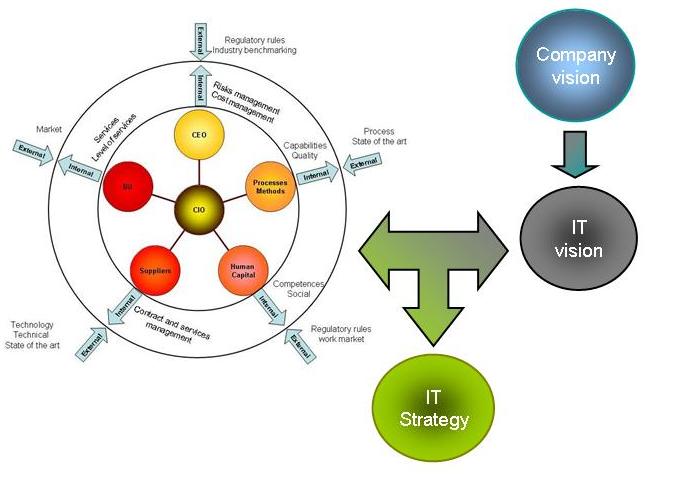In my previous post, I addressed the point of view that IT Strategy is not only business alignment, but should rely on a strong vision of IT role in the company.
Then, in this post, I propose to address the points of IT vision utility and how to build it with respect to IT Strategy.
Unfortunately, in the business world, few situations support to undertake no move, because usually stakeholders are facing externalities which raise questions on the way the company business is done. Beside, business undergo internal pressure when, for example, company reach poor execution performance in some areas.
The same happen for IT, if you choose to not move when all your environment is changing, you are quickly out of the business, or if you perform poorly you out your buiness at risks.
For example, take such a strategic goal for Business : “making 30% of company business with the new business model XXX”.
The strategic plan may include :
1. select target customers for this business model
2. conceive and release attractive conversion offerings regarding competitors and current customer position
3. prepare delivery in accordance to the expected quality level
All these items are questioning IT coming from an external source :
1. should the customer segment management be internal or outsourced ? in each case how to acquire and integrate ?
2. how to release offerings : channels, pricing, contract
3. should the production and delivery be outsourced or in sourced ? in each case how how to acquire and integrate ?
Then you have to analyse the internal status : level of coverage, quality of service, functional richness, business risks, technology risks linked with business
Once done, you may settle the goals to fill the gap and also identify in what extent poor performance is a weakness for reaching external goals.
For each goal, you define many scenarios of action plan : a preferred one and several alternates.
This is the approach for BU stakeholders. Once the same work has been done for other stakeholders, you have a web of goals and actions plans to do which is not still an IT Strategy.
Last step is prioritisation which allows the company management to select what he intend in accordance with a given level of resources.
The choosing of goals takes all actions plans linked from the company strategic web. This is the IT Strategy. But it is still not a vision of IT within the company. The company vision is more or less a business statement with some indications on how to do business.
The IT vision gives ultimately the long term IT value orientations : IT is critical or not for some aspects of company business, IT is a managed services provider, critical services should not be outsourced, either IT provides tools for business which choose what to do, or Business processes rely on IT,…
IT vision contains the fundamental goals which remain true along the different IT Strategies. It contributes to maintain coherence in actions along company lifetime.
It may happen that consecutively to a Strategic round IT has to upgrade IT vision,but this should remain an exceptional decision.
A strong IT vision is a critical success factor for IT strategy keeping out of a swing movement which may endanger IT capabilities.
